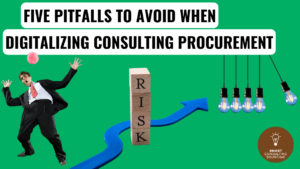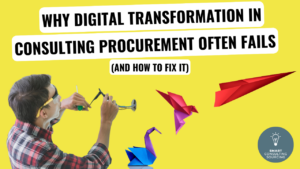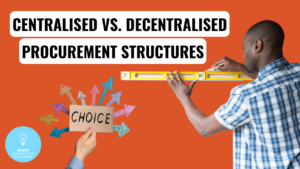Our 6-Levers podcast series is designed to help consulting buyers to make informed and educated decision while purchasing consulting services. Over the past episodes, we have explained several aspects of using 6 levers of optimizing ROI of consulting spend. Today, we will examine the first lever which is investing in the right project.
But before that, a quick recap of the previous episode.
In my previous episode, I gave a few pointers on what you need to know before you start using our6 levers to create more value through your consulting spend.
Business leaders and stakeholders must realize and accept that procurement transformation will impact on the entire organization and that the company as a whole can benefit from what best-in-class procurement can provide.
However, for any change to occur, procurement must have the support of senior management and key stakeholders. Ironically, they frequently do not care, and their lack of concern reveals the lack of collaboration between business lines and procurement.
Changing your mind-set is the first step toward increasing your consulting ROI.
Next, they must have a close at why they believe their ROI is not satisfying. This will provide them with a solid starting point for implementing our 6-lever technique.
And now, let’s jump onto today’s topic.
Today I’ll walk you through with a detailed analysis of using the first lever to create more value from your consulting spend.
Why Internal Projects Often Fail?
Have you ever seen an internal project fail because employees were too busy with their daily tasks to care about the project, and they were also afraid of taking risks that could jeopardize their careers? Of course, you have.
Consulting can help companies achieve more value than they would if they attempted the same projects independently. The right consultant brings focus and avoids common pitfalls. Projects done with support from a good consultant tend to be more successful than those completed internally without outside help. However, not all companies make use of consultants in the most effective way possible.
Sometimes they are overly reliant on it, while other times they underestimate its potential. The effective use of consulting relies both on a well-defined strategy and an agile execution to adjust the strategy when needed.
In traditional industries such as chemicals or manufacturing or small to mid-sized companies, executives often underutilize consulting services. They tend to think that consulting is expensive or that consultants do not really create value. Using consulting is seen as a sign of weakness and a waste of money.
However, the opposite can be true if used to its full potential. Consulting can help companies tackle a number of internal and external challenges such as developing new products, creating operational efficiencies, or finding ways to increase market share. It can also provide crucial insights into customer needs and behaviors that are often difficult to uncover internally.
In other industries, European executives have become so reliant on consultants that they can’t make a move without their help. A large bank recently noticed that, during a budget meeting supported by a consulting firm, all the different functions of the group had prepared the meeting with their own “private” consultant.
The bottom line is that consulting can be an invaluable resource when used effectively.
Obviously, not all projects are good candidates for consulting support. The most common mistake companies make is not Anticipating and Prioritizing their needs for consulting, which in turn causes them to rely on consultants anytime they need help or want to speed up the process. The first one to use the budget often gets the resources.
Now, it would be great if we had the resources to do it all ideally.
But in reality, you are limited by your resources, whether it is time, budget or skills. Sometimes, in order to make the most impactful and budget-friendly decisions, we must be selective about which projects we dedicate our resources to. By investing in the right projects, we can see a significant increase in results within a given timeframe.
Investing in the wrong project can be disastrous for a company, as progress will not only be slow but risk alienating your customer base too.
That’s why I often come across clients having “burned” their budget in the first two quarters of the year, only to find themselves struggling with any strategic project for last six months.
It’s almost as if their funds were seasonal, disappearing in a puff of smoke when summer arrives! Investing in the right projects from the outset is key to avoiding this scenario and ensuring business continuity throughout the year. With careful planning and some smart decisions, companies can make sure they’re getting value for money whilst also investing in worthy initiatives.
The benefits of doing so far outweigh chasing any fleeting trends or whims. To avoid this scenario, I recommend that companies invest time into understanding what projects the potential have to bring them the best returns.
Investing In the Right Project Starts with The Right Strategy
Think strategically: focus on projects that are either supporting your overall strategy, enabling other projects that support the strategy, or projects with a high impact and ROI. And how do you do that? First, you need to build your consulting strategy.
And it starts with your strategy. It reflects your vision, and your consulting projects should be fully synchronized with both.
However, most executives would recognize that, besides an ambitious strategy, success cannot happen without the alignment of all elements of the business, including the spend and the organization, to the overall strategy.
For the consulting spend, it means spending the right amount of money on the right projects and investing strategically in consulting can be a difficult decision.
The best way to get the most of your consulting budget is to integrate it early in your strategic planning. As we have mentioned, it is important to align your spending with your overall strategy. You can take this one step further by defining how you want to use consultants in your company by creating a consulting specific strategy that mirrors your companies’ mission and goals.
Break your high-level priorities down into clusters and decide how many resources you want to dedicate to each one.
Think about the potential projects and determine which cluster they would fall under. This will help you prioritize and sequence your projects, manage interdependencies, and make informed decisions about what to outsource or tackle yourself.
You can tailor the clusters used for this assignment to your organization. The key is to ensure you have a versatile plan that will let you select what’s best.
Not Sure Where to Start? Let Me Tell You How We Do It at Consulting Quest
Strategic Planning is about defining where to play, how to win, and how to allocate resources.
Operational Effectiveness projects are about making sure the operations are effective and efficient.
Growth and Innovation projects are about defining the opportunities to grow beyond the core.
Enablers & Governance projects are enablers for all the other clusters, including change.
Creating a consulting strategy is best done as a team. If you’re doing a lot of consulting, you should think about assigning a small group to handle the process and make sure the strategy gets executed. Don’t be afraid to mix up roles between teams like procurement, strategy, and various business lines.
The goal of this project is not to make decisions for the business lines, but rather to allow them keep control over consulting spending while still getting the most value from it. To do so, best practices must be put into place.
Now, after you’ve determined your consulting strategy, the next step is to set a budget.
A good budget will include both strategic initiatives that are needed to move the project forward and non-strategic but also high-ROI projects that can bring meaningful returns even if they aren’t essential for completing the project.
Okay, all this sounds good in theory. So, let me just give you guys a practical example of what I want to convey through this.
For instance, let’s say you’re a Manufacturing company caught in the crossfire of COVID and the impact of the war in Ukraine and struggling to come up with a sound strategy despite having limited resources. And you know that you have some issues in your production and supply chain activities that need improvement.
Investing in the Right Project – What Does It Mean for Your Business?
Investing in the right project wisely now means that you can better position yourself for an eventual turnaround without wrecking your finances right now.
This—to use a clichéd but fitting phrase—is a classic case of “measuring twice and cutting once.” Investing in the right projects today can potentially save you time, money & energy down the line by propelling you towards the growth and stability that comes with sound strategy.
So, you start with an operational project to fix your production and supply chain. That gives you some short-term savings and long-term efficiencies.
With that, you launch a small project on leadership team effectiveness.
You now have some budget left, and a leadership team aligned. So now, you can launch a strategy project.
See the first high-ROI project, second enabler, and third strategic project.
Once a Plan and Budget Are in Place, Then It’s Time to Apply Demand Management Guidelines
Demand management is a supply chain system that balances and strategically aligns demand with operating capability across the supply chain. The challenge of it often lies in its successful implementation for companies that are not well-prepared and fail to deliver the expected results.
In a limited budget scenario, your teams must be able to distinguish between “must have” and “good to have” items. And demand management enables your teams to make that distinction.
Demand management is a basic but indispensable tool for all organizations which can help them better manage their spending for indirect procurement such as consulting.
Organizations that wish to use demand management must set specific criteria for buying consulting services, prioritize projects based on how important they are to the organization’s strategy, and carefully consider all possible options before choosing to buy from a supplier.
Finally, demand management should be an ongoing process that enables organizations to utilize their budget more judiciously, have tighter control over spending, and reduce pressure on OPEX.
However, by stipulating thresholds and the involvement of top management in decision-making, demand management may make the process more rigid which may not be liked by executives accustomed to a more flexible system.
By taking the time to set up a comprehensive system of demand management, organizations can save money and resources in the long run. It requires dedication and commitment from all stakeholders, but it is definitely worth it.
In Conclusion,
So, to conclude today’s topic, the objective was that the clients should consider the consultancy category wisely.
Companies often underutilize consultants, thinking that they are expensive or that they do not really create value. Or they overutilize them, working with consultants at every turn. Or even worse, they work on the wrong projects.
If you consider consulting an investment rather than a necessary spend, or evil for some for you, you will select how to spend it early on.
Investing in consulting can be a difficult decision; one way to get more from a budget is to integrate it early in strategic planning. Aligning spending with overall strategy and creating a consulting-specific strategy can help companies make better use of resources.
And that means defining clusters of high-level priorities helps organizations prioritize and sequence projects, manage interdependencies, and make decisions about what to outsource or tackle themselves.
Then it is important for teams to be able to discern between projects that are “must-haves” and those that would simply be “nice to have.” This is where demand management becomes a useful tool. By overseeing organization spending, it helps prevent overuse of funds on indirect procurement, such as consulting fees. In this way, organizations can make the most out of their limited budgets.
While demand management enables organizations to use their budget more efficiently, have better spending control, and lower pressure on operational expenses etc., it may also make the process more inflexible by demanding certain thresholds and executive involvement in decisions. rid which may not be liked. Be sure to make it flexible enough to avoid frustration.
Take the time to set up a comprehensive system of demand management. It is definitely worth it.
I hope that you are now familiar with what investing in the right project mean. Or you can just come and ask us, at Consulting Quest.
So, keep an eye up for me next week when I return with our first lever topic.
Till then, stay safe and happy sourcing and if you have any questions regarding today’s topic, remember you can always contact me directly on LinkedIn or by email because I’m always game for a chat.
Bye and see you next week, au revoir.
See you at the next episode. Till then, please stay safe and stay connected with us through our community on LinkedIn and follow our Twitter handle @ConsQuest.
Don’t forget to like and subscribe to our channels.
Podbean
YouTube
Happy Sourcing!
Investing in the right projects Investing in the right projects Investing in the right projects Investing in the right projects Investing in the right projects Investing in the right projects Investing in the right projects Investing in the right projects Investing in the right projects Investing in the right projects Investing in the right projects Investing in the right projects Investing in the right projects Investing in the right projects Investing in the right projects Investing in the right projects Investing in the right projects Investing in the right projects Investing in the right projects Investing in the right projects Investing in the right projects Investing in the right projects Investing in the right projects Investing in the right projects Investing in the right projects Investing in the right projects Investing in the right projects Investing in the right projects Investing in the right projects Investing in the right projects Investing in the right projects Investing in the right projects Investing in the right projects







